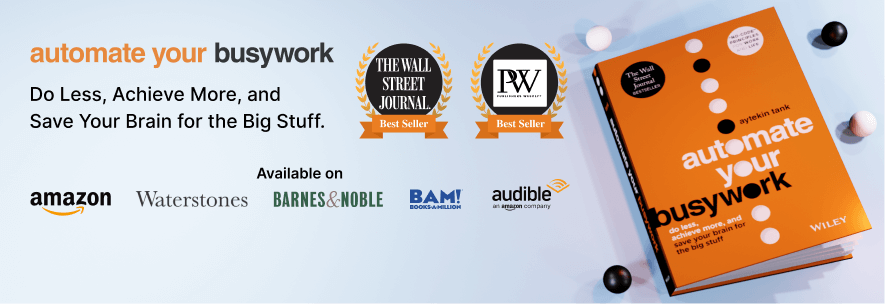Humans are wired to love a good before-and-after story.
We crave transformation, whether it’s fixing up an old house or turning a clever idea into a thriving business.
But pushing for that “after” state can lead us to overlook all the fun of getting started.
Sure, the early days of building a product or a business can be tough. There are late nights, financial struggles, mistakes, and self-doubt.
Yet, it’s also a great time to explore. You can experiment without millions of paying customers watching your every move.
And if you don’t have investors breathing down your neck, you can afford to play the long game. I bootstrapped my business and grew Jotform slowly, on my own terms.
It took 12 years to reach 3.2 million users and 100 employees, but I wouldn’t change anything. I’ve enjoyed the entire process — and I couldn’t have succeeded without embracing the freedom and learning of those early days.
But, how do you get started, especially if you’re not ready to quit your job?
You can begin, right now, to build a foundation that will support your business for years. Even if you’re not a software engineer (or you don’t have an MBA), there are smart ways to get the ball rolling.
Create a path for your product idea
Today’s startup media often celebrates the blind leap, but I believe in scoping out the terrain before you jump.
After college, I spent five years working as a programmer for a New York media company. That’s where I got the idea for JotForm.
But long before I wrote my resignation letter, I started taking small steps toward my goal. I prepared the soil.
Maybe you have a killer product or startup idea, but you’re not ready to go all-in. Or maybe you’re starting to tinker in your off-duty hours.
Either way, here are six steps you can take to deepen your knowledge, build a platform, and dramatically increase your chances of success.
1. Don’t quit your day job
Startup culture has made the term “day job” feel like a four-letter word, but I think that’s misguided, not to mention discouraging for millions of awesome employees.
The five years I spent working at the media company were invaluable. Not only did I gain so many important (and directly applicable) skills, but I also discovered how to stay productive and communicate well.
I watched how my mentors accomplished their goals, which helped me immensely when I was suddenly adrift, without a schedule or a boss looking over my shoulder.
Even negative experiences were valuable.
For example, I saw co-workers struggle with old computers and slow connections. That seemed like wasted potential.
I also realized that most people work better when they have some flexibility.
Few product people — especially developers and other creatives, like designers — thrive in a heavily prescriptive environment. I know I certainly don’t.
Many of these lessons translated directly into Jotform — and they still influence how our team operates today.
Never underestimate what you can learn and accomplish in a 9-to-5 position.
It can be so much more than a paycheck; the time you give to another company can teach you how to work effectively, spark new project ideas, and give you confidence to tackle that big startup idea.
2. Start a side project or two
Most people don’t bake a pie or make pasta from scratch before they can boil water. Side projects build your skills and allow you to sample new ideas.
Before I jumped ship and started my company, I worked on a series of side projects. I built small test products. I explored tangents and indulged my curiosity.
That’s also where I applied what I had absorbed from devouring all those books, blogs and articles.
Every time I embarked on a new project, I learned something essential about marketing, usability, product development, sales and customer support.
And here’s the other great thing about side projects: sometimes they succeed.
Many of my little projects faded away, but some sold well. In fact, a couple began earning enough money to match my full-time salary.
Those experiments gave me the safety net I needed to eventually quit my job. That also meant I didn’t need to ask friends, family or VCs to invest.
Many people talk a big game about their side projects, but I encourage you to actually do them.
Test your ideas. Play a little and see where they go. Try not to put too much pressure on yourself or your creativity, but give it a good shot.
A successful project could fund and launch your business. A less-than-amazing result will also be an invaluable teacher. It’s a win-win.
3. Share your work
I used to have a blog where I wrote about online technologies and my own side projects.
Whether your 2018 version of this platform is a Medium blog, a YouTube channel, a podcast or an amazing Instagram account, sharing your work is wildly beneficial for three reasons:
- Sharing can help you to build an audience before you build your startup. Then, you can leverage that following when you launch a product. That’s how I started to sell my side projects. It’s also how I funded the six months I spent working full-time to build JotForm. I realize the internet is a lot more crowded these days, and it doesn’t happen overnight, but consistently providing valuable content will attract the right people over time.
- It’s a great way to clarify and improve your ideas. If you want to learn something, try explaining it to someone else. You’ll immediately see the gaps in your knowledge. You’ll get smarter and people will begin to find value in your content.
- You establish a track record. Once you have something to launch, that audience already knows who you are and trusts your voice. They see that you’ve been covering the industry and maybe even showing your process along the way. Think about a ProductHunt post. If someone clicks through and sees a half-finished side project, without a blog or an online history of any kind, it doesn’t exactly build confidence in in the creators.
4. Learn from the experts
Never before have so many expert resources been right at our fingertips.
From online courses to workshops to blogs and videos, you can learn nearly anything, at any time, from smart, accomplished people. The internet is your educational oyster.
While I was still working full-time, I read everything I could find about building a successful software business.
Joel Spolsky and Paul Graham became my virtual mentors. They had created admirable companies and were sharing tactical advice on their blogs.
I also read books about startups and bootstrapping. I was voracious. Most importantly, I tried to immediately apply what I learned.
I think that’s the only way to ensure the lessons really stick. Otherwise, it’s like going to class without taking a test or writing a paper. You need to see if and how certain tactics actually work for you.
5. Stay on top of emerging technologies
Maybe you’re thinking, “well, yeah. I already do that.”
But there’s following tech trends and there’s following your instincts. Success requires you to do both.
For example, Google introduced Gmail in 2004. I was psyched when I first saw it. Single-page web apps felt like a bold step forward. JavaScript libraries and drag-and-drop functionality were also new on the scene.
It was an exciting time for the internet.
On developer forums, however, many people were laughing about web apps. Lots of experts weighed in, too. They said there was no way a web app could be as effective as a desktop app.
I thought these were powerful, new technologies, and I wanted to use them.
Clearly, I wasn’t the only person who felt this way. Lots of other founders saw their potential, and those of us who embraced these innovations (like using drag-and-drop to build web forms) got a head start on the industry.
6. Prioritize design and usability
Software has to be user friendly. This might seem like another “duh” statement, but stay with me.
Most developers and software engineers focus on code. They want to make a working product with lots of features.
But think for a moment about the disconnect. Users simply expect your product to work. That’s a given. Deliver something broken and they’re gone before you can blink.
If they’re choosing between two options, though, they’ll pick the one that feels slick and intuitive. We all know this from personal experience, but it’s easy to lose perspective with your own product.
Joel Spolsky was one of the first people to hammer this point home for me, and I’ve never forgotten his lessons.
So, as you’re reading and learning and preparing to leap, keep a close eye on design and usability. Go deep into these critical topics. They’re difference-makers in the product world and beyond.
Here’s the bottom line:
Few successful products are launched out of the blue. If you want to be an entrepreneur, prepare yourself.
Create side projects. Try to sell them. Develop marketing and support for your experiments. Building is one part of the equation, but releasing it to real users is different beast entirely. It’s an amazing learning experience.
While you’re doing all this serious prep work, don’t forget to have fun. My two young kids play all day long, because that’s how they learn. It’s a safe way to discover how the world works.
We should all be following their lead, whenever possible.
Pursue ideas that genuinely excite you. Trust your instincts. Learn how to become an entrepreneur by playing with side projects in a safe, low-pressure environment.
Good luck — and let me know what you’re building. I’d love to hear about it.
















Send Comment:
6 Comments:
More than a year ago
Thank you so much
More than a year ago
Hello Aytekin,
I just discovered your blogs this morning, and have been hooked to what you write. Just wanted to share I am feeling very motivated and inspired after reading about your work and how you built JotForm. Continue doing the good work that you are doing for your team and for the community!
Thank You,
Shubhada
More than a year ago
Very good article, for many who are pondering to make shift or to take plunge. A validating and cautious, build test and leap approach being study sounds good, rather otherwise in present startup scenario specially in IT, seeing so many fails. Not been considered and always light on shiny and successful, giving a illusion.
More than a year ago
“Don’t quit your job yet: how to lay the foundation for a successful startup”
… Yeah, wish I’d read this a couple of years ago. I saved up $50K and quit my well paid software job. Thought that would be enough to get my startup running, but ran out of cash 12 months later and promptly lost my lead and best developer to Mr (vacuum) Dyson.
Since then, I’ve been so distracted trying to make ends meet that I can’t move forward with the startup. Luckily my wife earns enough to keep us alive, but she is getting might sick of me begging for cash!
David - founder droidscript.org
More than a year ago
I discovered your blog recently and your approach really resonates. Very similar to how Basecamp operates and it's a model I want to follow. I'm starting out in much the same way you did and I hope to continue following the same approach.
One thing I'm struggling with is what to do about a co-founder. All the gurus say it is essential to have a co-founder but it's not easy finding the right person. Am I right in guessing you're a solo founder? If so, I'd love to see a blog post about how you coped with that.
More than a year ago
Excellent post Aytekin. I pretty much took same path before creating
Thanks for sharing.